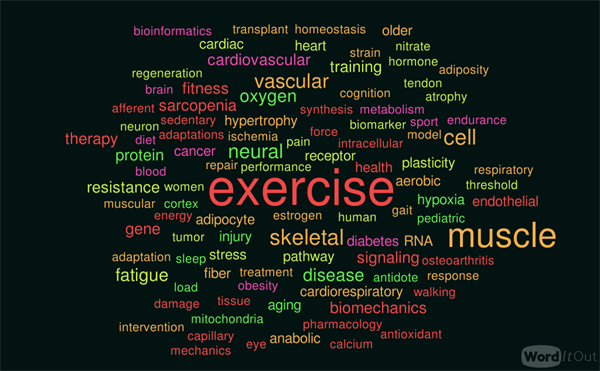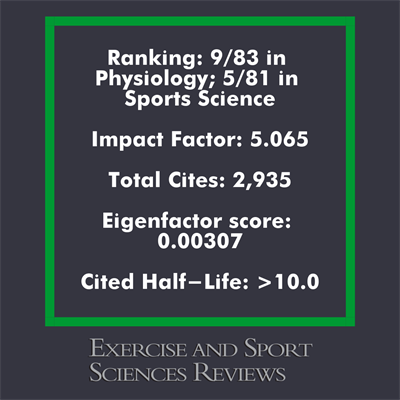Roger M. Enoka, Ph.D. |
Jan.
4, 2019
As is typical in each calendar since 2000, ACSM published four issues of Exercise and Sport Sciences Reviews (ESSR) in 2018: at the beginning of January, April, July, and October. The journal publishes forward-looking content that either provides the rationale for a novel hypothesis or summarizes work on a contemporary issue and then identifies the key gaps in knowledge that need to be addressed to move the field forward. Critically, the content encompasses the 11 topical areas that comprise the foundation for the annual ACSM meeting.
 To illustrate the scope of this content, the image (right) shows a word cloud constructed from the key words for the 32 papers that were published in 2018. The size of each word in the diagram indicates the frequency with which it was mentioned in these papers. Not surprisingly, the most frequently used key word was “exercise,” which is appropriate given the name of the journal. Note also that the key words range from the molecular to population levels of analysis.
To illustrate the scope of this content, the image (right) shows a word cloud constructed from the key words for the 32 papers that were published in 2018. The size of each word in the diagram indicates the frequency with which it was mentioned in these papers. Not surprisingly, the most frequently used key word was “exercise,” which is appropriate given the name of the journal. Note also that the key words range from the molecular to population levels of analysis.
The relative interest in these 32 papers can be quantified by comparing the numbers of times the online version of each paper is viewed. The online content can be viewed either through an institutional subscription to the journal (Ovid) or through the journal website itself. The most frequently viewed 2018 paper differed for the two platforms. The most popular paper through Ovid was a provocative perspective written by Mike Joyner and Carsten Lundby on the topic of maximal oxygen consumption and trainability. They challenged the findings that claim some humans are less responsive than others to training interventions designed to increase maximal oxygen consumption. The responsiveness of individuals to this specific training stimulus has public-health implications due to the association between fitness and all-cause and cardiovascular mortality. They discuss the factors that can contribute to the variation in the response to training among middle-aged and older adults and suggest that another wave of twin studies is needed to resolve some of these issues.
The most accessed paper through the journal site was written by Amanda Tyndall and colleagues and presented a novel hypothesis on the influence of exercise on cognition and brain health in older adults. The specific issue they addressed was the moderating influence of exercise on the association between declines in cognitive function with advancing age and the risk of developing Alzheimer disease and related dementias. They propose that exercise has a beneficial impact on cognitive function through multiple mechanisms that together promote healthy aging of the human brain. Their model provides the foundation for a range of studies that can disentangle the influence of specific exercise attributes on the various features of cognitive function.
 The papers to be published in 2019 will continue this format of synthesizing contemporary knowledge in our field and suggesting directions for future research. The planned content will include authoritative perspectives on:
The papers to be published in 2019 will continue this format of synthesizing contemporary knowledge in our field and suggesting directions for future research. The planned content will include authoritative perspectives on:
- strategies to increase population levels of physical activity,
- the role of physical activity in vascular insulin resistance in skeletal muscle and brain,
- the influence of exercise on the gut microbiome,
- blood pressure control during dynamic exercise,
- the periodization of carbohydrate performance availability to augment sports performance, and
- a framework for evaluating wearable sensors.
We hope our content will continue to be of interest to you and, as always, encourage you to send us suggestions on topics and authors we should consider for inclusion in the journal.
Most Read Articles of 2018
Concepts About VO2max and Trainability Are Context Dependent
Protective Effects of Exercise on Cognition and Brain Health in Older Adults *Journal Club
The Impact of Aerobic Exercise on the Muscle Stem Cell Response *Journal Club
Exercise and the Tumor Microenvironment: Potential Therapeutic Implications *Journal Club
Dietary Nitrate Enhances the Contractile Properties of Human Skeletal Muscle
Sedentary Behaviors and Adiposity in Young People *Video Abstract
Potential Role of MicroRNA in the Anabolic Capacity of Skeletal Muscle With Aging *Video Abstract
Identifying Novel Signaling Pathways: An Exercise Scientists Guide to Phosphoproteomics *Journal Club **Supplemental Digital Content
Modulation of Energy Expenditure by Estrogens and Exercise in Women *Video Abstract
The Microvasculature and Skeletal Muscle Health in Aging *Video Abstract
Specificity of "Live High-Train Low" Altitude Training on Exercise Performance
Exercise Is an Adjuvant to Contemporary Dystrophy Treatments
Skeletal Muscle Function in the Oldest-Old: The Role of Intrinsic and Extrinsic Factors
Conversation Starters: Highest Altmetric Attention Score
Altmetric calculates a score based on the online attention an article receives. The score is calculated based on two main sources of online attention: social media and mainstream news media.
Modeling Overuse Injuries in Sport as a Mechanical Fatigue Phenomenon
Protective Effects of Exercise on Cognition and Brain Health in Older Adults *Journal Club
Mechanical Coupling Between Muscle-Tendon Units Reduces Peak Stresses
Resistance Exercise’s Ability to Reverse Cancer-Induced Anabolic Resistance
Potential Roles of Vascular Endothelial Growth Factor During Skeletal Muscle Hypertrophy
Dietary Nitrate Enhances the Contractile Properties of Human Skeletal Muscle
Skeletal Muscle Function in the Oldest-Old: The Role of Intrinsic and Extrinsic Factors
Sedentary Behaviors and Adiposity in Young People *Video Abstract
The Importance of mTOR Trafficking for Human Skeletal Muscle Translational Control
Exercise and the Tumor Microenvironment *Journal Club
ACSM Professional Members have access to both print and digital subscriptions to ESSR, as well as additional ACSM journals Medicine & Science in Sports & Exercise®, Current Sports Medicine Reports(Physician Members Only) and the Translational Journal of the American College of Sports Medicine. Further, members receive discounts on ACSM certification exams, meeting and conference registrations, ACSM continuing education credits and more. Learn more and join today!
 Roger M. Enoka, Ph.D., is a professor of integrative physiology at the University of Colorado Boulder. He is the current Editor-in-Chief of Exercise and Sport Sciences Reviews (ESSR).
Roger M. Enoka, Ph.D., is a professor of integrative physiology at the University of Colorado Boulder. He is the current Editor-in-Chief of Exercise and Sport Sciences Reviews (ESSR).